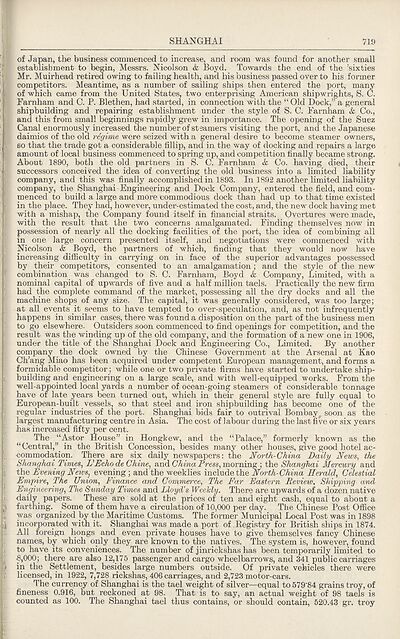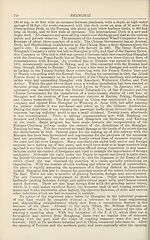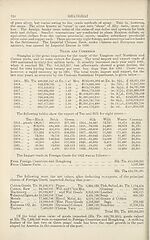1924
(793) Page 719
Download files
Complete book:
Individual page:
Thumbnail gallery: Grid view | List view

SHANGHAI
719
of Japan, the business commenced to increase, and room was found for another small
establishment to begin, Messrs. Nicolson & Boyd. Towards the end of the ’sixties
Mr. Muirhead retired owing to failing health, and his business passed over to his former
competitors. Meantime, as a number of sailing ships then entered the port, many
of which came from the United States, two enterprising American shipwrights, S. C.
Farnham and C. P. Blethen, had started, in connection with the “Old Dock,” a general
shipbuilding and repairing establishment under the style of S. C. Farnham & Co.,
and this from small beginnings rapidly grew in importance. The opening of the Suez
Canal enormously increased the number of steamers visiting the port, and the Japanese
daimios of the old regime were seized with a general desire to become steamer owners,
so that the trade got a considerable fillip, and in the way of docking and repairs a large
amount of local business commenced to spring up, and competition finally became strong.
About 1890, both the old partners in S. C. Farnham & Co. having died, their
successors conceived the idea of converting the old business into a limited liability
company, and this was finally accomplished in 1893. In 1892 another limited liability
company, the Shanghai Engineering and Dock Company, entered the field, and com¬
menced to build a large and more commodious dock than had up to that time existed
in the place. They had, however, under-estimated the cost, and, the new dock having met
with a mishap, the Company found itself in financial straits. Overtures were made,
with the result that the two concerns amalgamated. Finding themselves now in
possession of nearly all the docking facilities of the port, the idea of combining all
in one large concern presented itself, and negotiations were commenced with
Nicolson & Boyd, the partners of which, finding that they would now have
increasing difficulty in carrying on in face of the superior advantages possessed
by their competitors, consented to an amalgamation; and the style of the new
combination was changed to S. C. Farnham, Boyd & Company, Limited, with a
nominal capital of upwards of five and a half million taels. Practically the new firm
had the complete command of the market, possessing all the dry docks and all the
machine shops of any size. The capital, it was generally considered, was too large;
at all events it seems to have tempted to over-speculation, and, as not infrequently
happens in similar cases, there was found a disposition on the part of the business men
to go elsewhere. Outsiders soon commenced to find openings for competition, and the
result was the winding up of the old company, and the formation of a new one in 1906,
under the title of the Shanghai Dock and Engineering Co., Limited. By another
company the dock owned by the Chinese Government at the Arsenal at Kao
Ch’ang Miao has been acquired under competent European management, and forms a
formidable competitor; while one or two private firms have started to undertake ship¬
building and engineering on a large scale, and with well-equipped works. From the
well-appointed local yards a number of ocean-going steamers of considerable tonnage
have of late years been turned out, which in their general style are fully equal to
European-built vessels, so that steel and iron shipbuilding has become one of the
regular industries of the port. Shanghai bids fair to outrival Bombay soon as the
largest manufacturing centre in Asia. The cost of labour during the last five or six years
has increased fifty per cent.
The “Astor House” in Hongkew, and the “Palace,” formerly known as the
“Central,” in the British Concession, besides many other houses, give good hotel ac¬
commodation. There are six daily newspapers: the North-China Daily News, the
Shanghai Times, L'Echo de Chine, and China Press, morning ; the Shanghai Mercury and
the Evening News, evening ; and the weeklies include the North-China Herald, Celestial
Empire, The Union, Finance and Commerce, The Far Eastern Review, Shipping and
Engineering, The Sunday Times and Lloyd’s Weekly. There are upwards of a dozen native
daily papers. These are sold at the prices of ten and eight cash, equal to about a
farthing. Some of them have a circulation of 10,000 per day. The Chinese Post Office
was organized by the Maritime Customs. The former Municipal Local Post was in 1898
incorporated with it. Shanghai was made a port of Registry for British ships in 1874.
All foreign hongs and even private houses have to give themselves fancy Chinese
names, by which only they are known to the natives. The system is, however, found
to have its conveniences. The number of jinrickshas has been temporarily limited to
•8,000; there are also 12,175 passenger and cargo wheelbarrows, and 341 public carriages
in the Settlement, besides large numbers outside. Of private vehicles there were
licensed, in 1922, 7,728 rickshas, 406 carriages, and 2,723 motor-cars.
The currency of Shanghai is the tael weight of silver—equal to 579'84 grains troy, of
fineness 0.916, but reckoned at 98. That is to say, an actual weight of 98 taels is
counted as 100. The Shanghai tael thus contains, or should contain, 520.43 gr. troy
719
of Japan, the business commenced to increase, and room was found for another small
establishment to begin, Messrs. Nicolson & Boyd. Towards the end of the ’sixties
Mr. Muirhead retired owing to failing health, and his business passed over to his former
competitors. Meantime, as a number of sailing ships then entered the port, many
of which came from the United States, two enterprising American shipwrights, S. C.
Farnham and C. P. Blethen, had started, in connection with the “Old Dock,” a general
shipbuilding and repairing establishment under the style of S. C. Farnham & Co.,
and this from small beginnings rapidly grew in importance. The opening of the Suez
Canal enormously increased the number of steamers visiting the port, and the Japanese
daimios of the old regime were seized with a general desire to become steamer owners,
so that the trade got a considerable fillip, and in the way of docking and repairs a large
amount of local business commenced to spring up, and competition finally became strong.
About 1890, both the old partners in S. C. Farnham & Co. having died, their
successors conceived the idea of converting the old business into a limited liability
company, and this was finally accomplished in 1893. In 1892 another limited liability
company, the Shanghai Engineering and Dock Company, entered the field, and com¬
menced to build a large and more commodious dock than had up to that time existed
in the place. They had, however, under-estimated the cost, and, the new dock having met
with a mishap, the Company found itself in financial straits. Overtures were made,
with the result that the two concerns amalgamated. Finding themselves now in
possession of nearly all the docking facilities of the port, the idea of combining all
in one large concern presented itself, and negotiations were commenced with
Nicolson & Boyd, the partners of which, finding that they would now have
increasing difficulty in carrying on in face of the superior advantages possessed
by their competitors, consented to an amalgamation; and the style of the new
combination was changed to S. C. Farnham, Boyd & Company, Limited, with a
nominal capital of upwards of five and a half million taels. Practically the new firm
had the complete command of the market, possessing all the dry docks and all the
machine shops of any size. The capital, it was generally considered, was too large;
at all events it seems to have tempted to over-speculation, and, as not infrequently
happens in similar cases, there was found a disposition on the part of the business men
to go elsewhere. Outsiders soon commenced to find openings for competition, and the
result was the winding up of the old company, and the formation of a new one in 1906,
under the title of the Shanghai Dock and Engineering Co., Limited. By another
company the dock owned by the Chinese Government at the Arsenal at Kao
Ch’ang Miao has been acquired under competent European management, and forms a
formidable competitor; while one or two private firms have started to undertake ship¬
building and engineering on a large scale, and with well-equipped works. From the
well-appointed local yards a number of ocean-going steamers of considerable tonnage
have of late years been turned out, which in their general style are fully equal to
European-built vessels, so that steel and iron shipbuilding has become one of the
regular industries of the port. Shanghai bids fair to outrival Bombay soon as the
largest manufacturing centre in Asia. The cost of labour during the last five or six years
has increased fifty per cent.
The “Astor House” in Hongkew, and the “Palace,” formerly known as the
“Central,” in the British Concession, besides many other houses, give good hotel ac¬
commodation. There are six daily newspapers: the North-China Daily News, the
Shanghai Times, L'Echo de Chine, and China Press, morning ; the Shanghai Mercury and
the Evening News, evening ; and the weeklies include the North-China Herald, Celestial
Empire, The Union, Finance and Commerce, The Far Eastern Review, Shipping and
Engineering, The Sunday Times and Lloyd’s Weekly. There are upwards of a dozen native
daily papers. These are sold at the prices of ten and eight cash, equal to about a
farthing. Some of them have a circulation of 10,000 per day. The Chinese Post Office
was organized by the Maritime Customs. The former Municipal Local Post was in 1898
incorporated with it. Shanghai was made a port of Registry for British ships in 1874.
All foreign hongs and even private houses have to give themselves fancy Chinese
names, by which only they are known to the natives. The system is, however, found
to have its conveniences. The number of jinrickshas has been temporarily limited to
•8,000; there are also 12,175 passenger and cargo wheelbarrows, and 341 public carriages
in the Settlement, besides large numbers outside. Of private vehicles there were
licensed, in 1922, 7,728 rickshas, 406 carriages, and 2,723 motor-cars.
The currency of Shanghai is the tael weight of silver—equal to 579'84 grains troy, of
fineness 0.916, but reckoned at 98. That is to say, an actual weight of 98 taels is
counted as 100. The Shanghai tael thus contains, or should contain, 520.43 gr. troy
Set display mode to:
![]() Universal Viewer |
Universal Viewer | ![]() Mirador |
Large image | Transcription
Mirador |
Large image | Transcription
Images and transcriptions on this page, including medium image downloads, may be used under the Creative Commons Attribution 4.0 International Licence unless otherwise stated. ![]()
| Asian directories and chronicles > 1924 > (793) Page 719 |
|---|
| Permanent URL | https://digital.nls.uk/196434192 |
|---|
| Attribution and copyright: |
|
|---|---|
| Description | Volumes from the Asian 'Directory and Chronicle' series covering 1917-1941, but missing 1919 and 1923. Compiled annually from a multiplicity of local sources and research. They provide listings of each country's active corporations, foreign residents and government agencies of all nationalities for that year, together with their addresses. Content includes: various treaties; coverage of conflicts; currencies and taxes; consular fees; weights and measures; public holidays; festivals and traditions. A source of information for both Western states and communities of foreigners living in Asia. Published by Hongkong Daily Press. |
|---|---|
| Shelfmark | H3.86.1303 |
| Additional NLS resources: |

